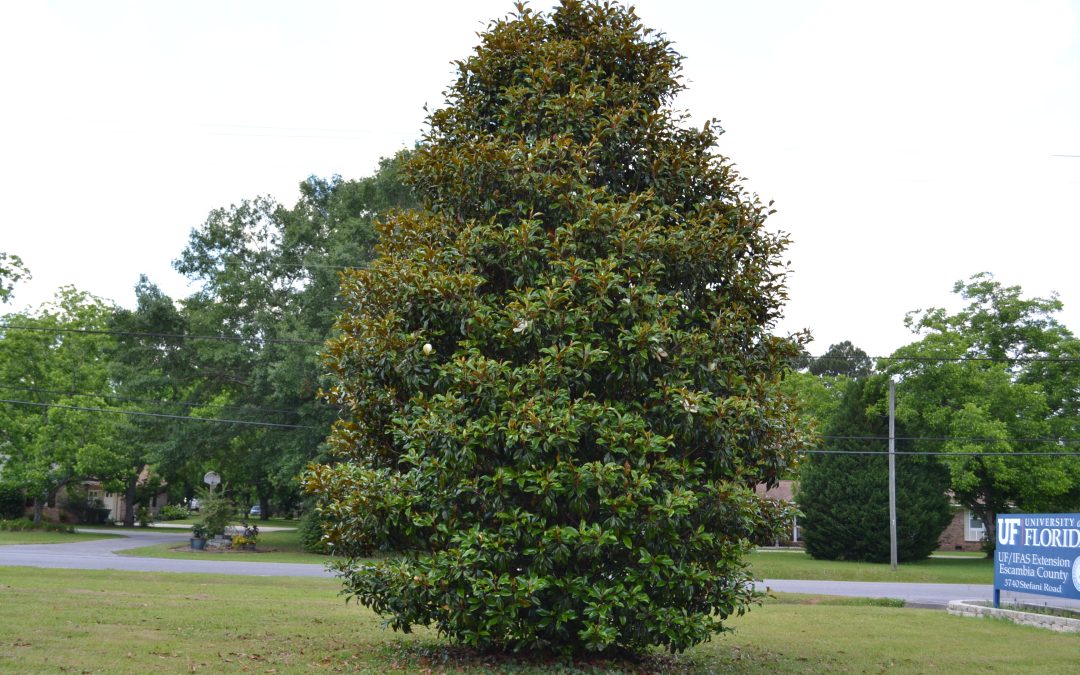
Video: Choosing the Best Location for a Southern Magnolia
Southern magnolia makes an attractive tree in the Florida landscape. Choosing the best spot for your tree is important for its optimum growth.

Southern magnolia makes an attractive tree in the Florida landscape. Choosing the best spot for your tree is important for its optimum growth.
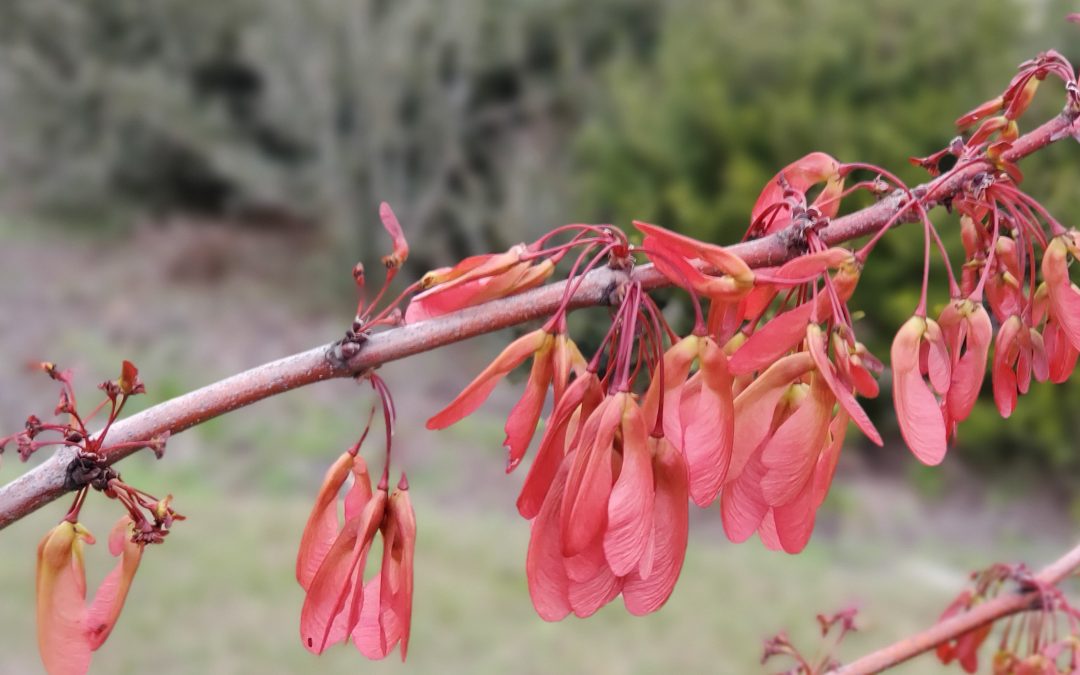
A month ago, when the Panhandle was covered in snow, it would have been hard to imagine that spring was just around the corner. But warm spring weather has arrived, and with it, the first of our native trees to bloom each year – the venerable Red Maple (Acer rubrum). Reliably heralding spring in Northwest Florida each February, Red Maples adorn our roadsides and low-lying natural areas with brilliant red blooms. Spotting a Red Maple blooming amongst the otherwise drab landscape means winter is on its way out and spring has sprung – or will shortly.
Beyond the blooms, Red Maple has much to offer as a landscape tree. For one, it is unbelievably adaptable. Across its native range – one of the most expansive of any species in the US, occurring naturally from Maine all the way down to the Everglades,* the tree can handle soils that range from periodically inundated along streams and other wet areas to more well-drained upland sites. Adding to its adaptability, in the Panhandle, Red Maple typically tops out around 40’ in height and around 20’ wide with a spreading vase shape, rarely growing out of scale with most landscapes.
*Since Red Maple occurs over a huge area of the US, it’s important to purchase seedlings or named varieties that hail from areas with like climate conditions to the Panhandle. Avoid varieties from northern states for best performance.
Red Maple is one of the few shade trees that has true four-season interest in our area. We’ve already talked about its spring flowers, but it also has attractive deep green foliage in the summer (some selections, like ‘Summer Red’ are even known for reddish purple new growth), famous fall color (though it is more muted in Florida than locales farther north), and unique ridged light gray bark in the winter. The seeds of Red Maple are even pretty. These two-winged seed structures, called a samara, follow the spring flower show, appear pinkish red, and are a favorite of squirrels and other critters.
Red Maple is a quick growing, low maintenance tree as well. If planted correctly and properly cared for, the species can grow several feet per year in its youth. Site the tree in a moist site that receives full sun, plant slightly higher than the soil level of the container the tree was purchased in to compensate for soil settling post-planting, and water regularly until established. After establishment, periodic fertilizing with a balanced fertilizer will help ensure Red Maple’s nutritional needs are met and maximum growth achieved.
If you’ve been looking for a medium-sized, native, flowering shade tree with four-season interest, Red Maple may be just the tree for your landscape. Plant one today! For more information on Red Maple, other recommended landscape plants, or any other horticultural topic, contact your local UF/IFAS Extension office.
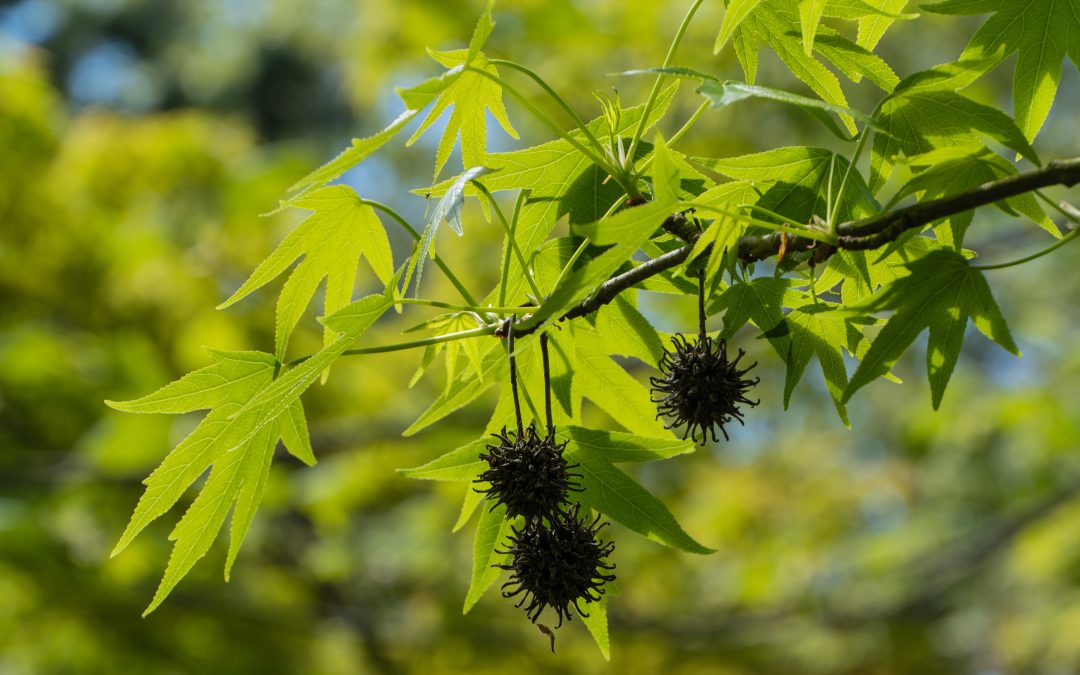
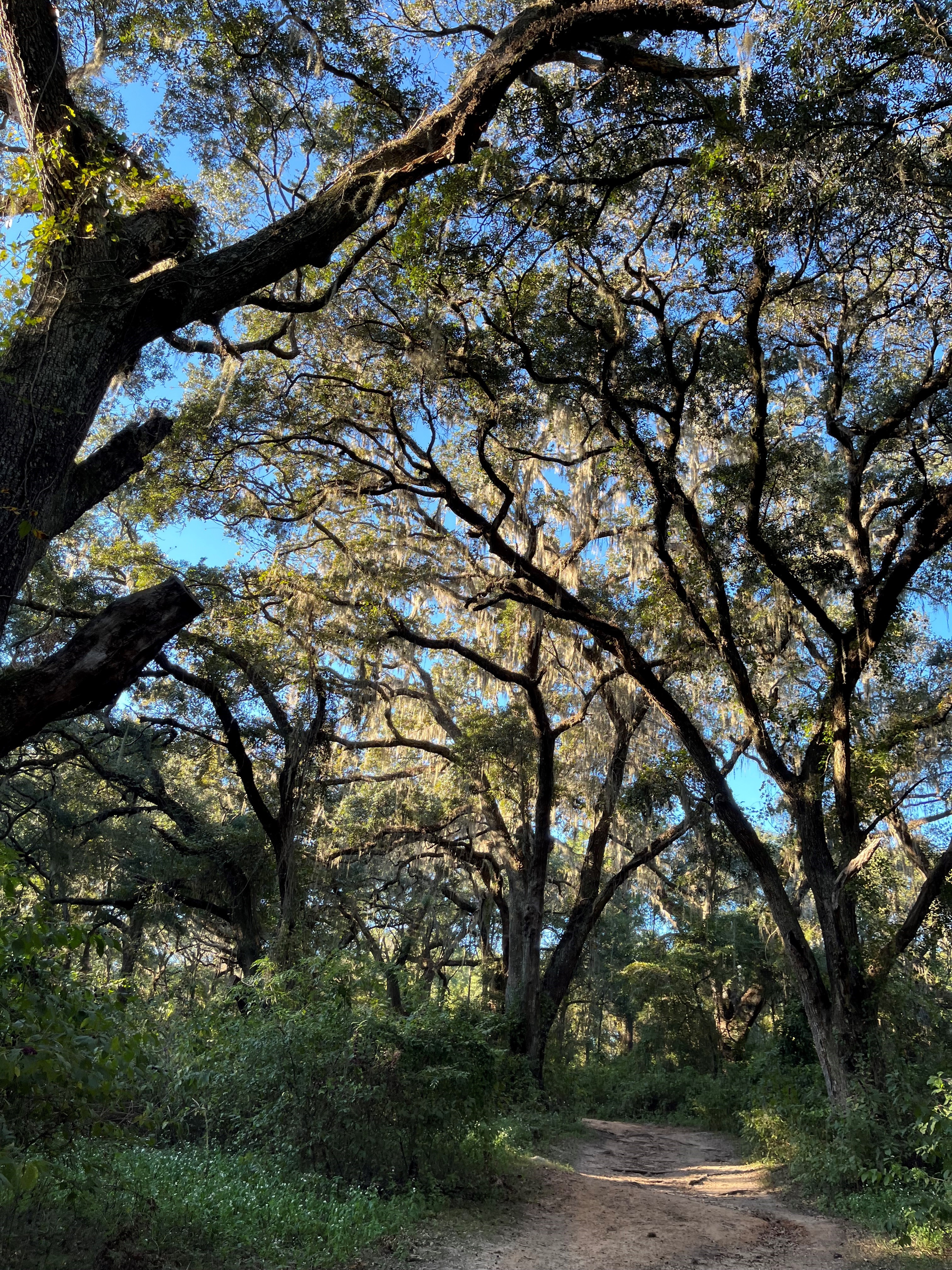
Trees provide shade, habitat, food, clean air, and beauty, but many also release windborne pollen that travels for miles, making spring challenging for allergy sufferers. Photo by Molly Jameson.
Spring in the Florida Panhandle brings blooming azaleas, singing birds, and a familiar yellow haze coating everything in sight. Yes, it’s tree pollen season, and if you’ve ever stepped outside only to feel your sinuses stage a full-scale rebellion, you have the trees to thank. Tree pollen is nature’s glitter – everywhere, impossible to escape, and surprisingly potent in small doses. While trees play a vital role in the environment, for allergy sufferers like me, their pollen can make spring feel like a months-long battle of sneezing, congestion, and itchy eyes.
Many people assume that showy, flowering trees are the biggest culprits, but this isn’t the case. Trees like magnolias and dogwoods rely on insect pollination, meaning their pollen is heavier and doesn’t travel far. The real troublemakers are wind-pollinated trees, which release huge volumes of lightweight pollen that can drift for miles and then straight into your sinuses.
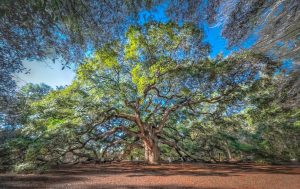
Oak trees are a staple of North Florida’s landscape, but their long pollen season makes them a top allergy culprit. Their lightweight pollen spreads easily, coating surfaces in yellow dust. Photo by Joseph Scopino, Bugwood.org.
Pollen production isn’t the same every year. Weather plays a big role – wind increases pollen spread, while rain helps suppress it. An unusually mild winter can start allergy season earlier and extend it longer, making some years worse than others.
To help you prepare, here are the top tree pollen offenders in our area, ranked using the Ogren Plant-Allergy Scale (OPALS), which rates allergenicity on a scale from 1 (least allergenic) to 10 (most allergenic).
Oak Trees (Quercus spp.)
OPALS Rating: 8
Pollen Season: February – May
Oaks are a staple of North Florida’s landscape, but they’re also one of the worst allergy offenders. Their pollen is light, easily airborne, and can travel miles on the wind. Even if you don’t have an oak in your yard, there’s a good chance one down the street is still making you sneeze.
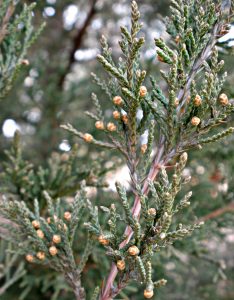
Male cones on Eastern Red Cedar release highly allergenic pollen in winter, often triggering “Cedar Fever.” Photo by Ansel Oommen, Bugwood.org.
Unlike other trees that release pollen in short bursts, oak trees drag out the misery from February through May, ensuring that allergy season lasts as long as possible. Because oaks are so widespread in urban and suburban areas, their moderate to high allergenicity makes them nearly impossible to avoid.
Eastern Red Cedar (Juniperus virginiana)
OPALS Rating: 10
Pollen Season: December – February
If you thought spring allergies were bad, Eastern Red Cedar makes sure some people suffer before spring even arrives. As one of the few trees to release pollen in winter, these evergreens begin shedding their highly allergenic pollen as early as December, peaking through February.
Cedar pollen is light, fine, and easily airborne, meaning it travels far and lingers in the air. The term “Cedar Fever” is well known in the Southeast for a reason – this tree’s severe allergenicity causes congestion, itchy eyes, and sneezing fits for many people, sometimes mistaken for winter colds. While red cedars provide valuable windbreaks and habitat for birds, their OPALS rating makes them one of the most problematic trees for allergy sufferers in North Florida.
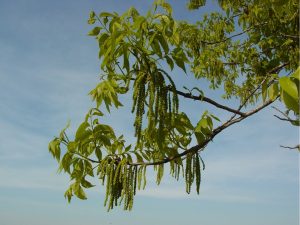
Pecan trees release long, dangling catkins in spring, shedding large amounts of wind-borne pollen. Photo by Charles T. Bryson, USDA Agricultural Research Service, Bugwood.org.
Hickory and Pecan (Carya spp.)
OPALS Rating: 8
Pollen Season: March – May
Closely related members of the walnut family, hickory and pecan trees may produce delicious nuts, but their wind-pollinated pollen is highly allergenic. Released in massive amounts from March through May, their pollen spreads far and often trigger strong allergic reactions.
Hickory pollen is especially potent, meaning even small amounts can cause sneezing, congestion, and itchy eyes. These trees are less common in urban settings compared to oaks, but in rural areas and agricultural landscapes, they can be a significant contributor to allergy misery.
American Sweetgum (Liquidambar styraciflua)
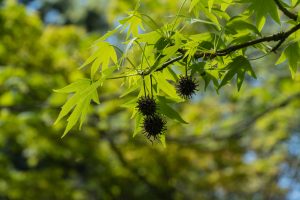
Sweetgum trees release allergenic pollen in spring, while their spiky seed pods linger long after. Photo by Alexander Denisenko, Adobe Stock.
OPALS Rating: 7
Pollen Season: March – May
While sweetgum trees are famous (or infamous) for their spiky seed pods, they’re also a problem during allergy season. Their wind-dispersed pollen, released from March through May, is known to trigger congestion and sneezing fits.
Although sweetgums have moderate to high allergenic potential, they do offer some benefits. They provide excellent fall color and support wildlife, so they’re not all bad – unless you’re allergic, in which case you might prefer to admire them from afar.
Pines (Pinus spp.), The Surprisingly Milder Offender
OPALS Rating: 4
Pollen Season: February – April
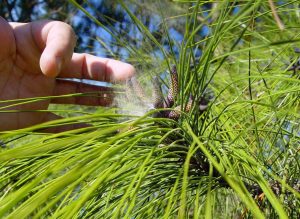
Each spring, pine pollen coats cars and sidewalks in a yellow-green haze. Though abundant, its heavier grains make it less allergenic than oak or cedar. Photo by Chris Evans, University of Illinois, Bugwood.org.
Wait, what about pine trees? If you’ve lived in North Florida for long, you’re probably familiar with the thick yellow-green coating of pollen that covers cars, sidewalks, and ponds every spring. It’s so visible that it seems like a top allergy culprit.
But here’s the twist: pine pollen is not as bad as you think. Despite its overwhelming presence, pine pollen is significantly less allergenic than oak, cedar, or pecan pollen. Its grains are larger and heavier, meaning they don’t stay airborne for long and are less likely to cause severe allergic reactions.
That said, sheer volume makes pine pollen hard to ignore. Pines are among the most common trees in Florida, and they release huge amounts of pollen from February through April. While their low to moderate allergy impact means they don’t cause major issues for most people, prolonged exposure can still be irritating – especially for those already dealing with other tree pollen allergies.
Other Notable Offenders

Red maple trees are among the first to release pollen in late winter, often kicking off allergy season. Their tiny, wind-dispersed pollen grains have a high allergenic impact. Photo by Gitta Hasing, UF/IFAS.
While the trees above may be the biggest allergy triggers, they aren’t the only ones sending pollen into the air. Red Maples (Acer rubrum) have an OPALS rating of 9, making them one of the most allergenic early bloomers. Their pollen often kicks off allergy season before winter fully ends, making them a significant irritant for those sensitive to tree pollen. American Elm (Ulmus americana), rated at 8, is another strong contributor, especially in urban areas where it has been widely planted.
Another surprising allergy trigger is Bald Cypress (Taxodium distichum), with an OPALS rating of 8. Though more commonly associated with wetlands and swamps, Bald Cypress releases significant amounts of pollen in the spring, making it an unexpected culprit. Sycamore (Platanus occidentalis), rated at 9, is a major pollen producer in North Florida, commonly found in parks and near waterways. Its fine, wind-dispersed pollen spreads easily, making it another frequent cause of allergy symptoms.
Managing Pollen Season
Tree pollen season in the Panhandle can be relentless, but a few simple precautions can help reduce exposure. Check pollen forecasts and limit outdoor activities on high-pollen days. Keep windows closed and use air filters indoors to minimize allergens. Since pollen clings to clothes, hair, and skin, showering and changing after being outside can prevent it from following you indoors. If you’re planning new landscaping, opt for low-pollen or female trees to reduce airborne allergens. With a little preparation, you can enjoy spring – without spending the whole season sneezing.
To learn more about trees that cause allergens and how they impact our region, check out the UF/IFAS Extension publication, Urban Trees and Allergies in North Florida.
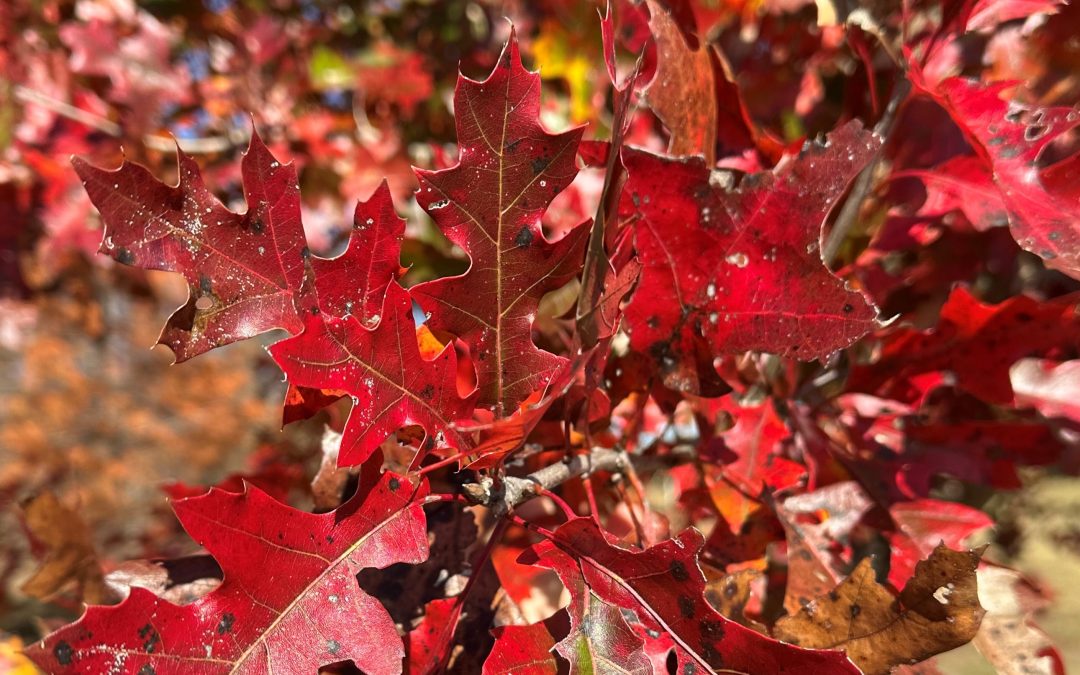
The Panhandle isn’t known for its fall foliage. The best we can normally hope for are splashes of pale yellow amidst a sea of green pine needles, drab brown leaves killed by the first frost, and invasive Chinese Tallow trees taunting us with vibrant colors we know we shouldn’t have. However, in 2024, you’d be forgiven if you forgot you were in Florida and had instead been transported to a more northern clime where leaves everywhere turned brilliant shades of yellow, orange, purple, and red. I’ve heard comments from many folks, and I agree, that this is the best fall color we’ve seen here in a long time – maybe ever. So, why were the leaves so pretty this past year? Let’s dive in.
What causes leaves to change colors in the fall?
First, what makes leaves of deciduous trees/shrubs (plants that shed their leaves in the winter) change color in the first place? The primary driver of leaf color change is daylength. During the summer, leaves appear green due to the presence of chlorophyll, which reflects green light, absorbs red and blue light, and is responsible for photosynthesis. When days shorten in the fall, plants sense that winter is coming and produce hormones that signal leaves to shut down chlorophyll production. They then initiate construction of a “wall” of cells that seals leaves off from the rest of the plant. When this happens, existing chlorophyll is “used up”, sugars build up in the now sealed off leaves, and other compounds that give leaves color, anthocyanins and carotenoids, take center stage. These compounds allow leaves to exhibit the familiar autumnal hues of yellow, red, orange, purple, and brown. However, plants go through this physiological process of shutting down growth and shedding leaves every year and excellent fall color. What we experienced this year, doesn’t always result. There has to be more to the fall 2024 story.
Why were leaves so pretty this year?
A second factor is required for a great fall foliage show – weather. According to the U.S. Forest Service, ideal temperature and moisture conditions must be met for leaf color to be its most intense. Ideal autumn conditions include warm (but not hot) sunny days with cool (but not freezing) nights and adequate (but not excessive) moisture. Too hot and plants become stressed, lessening fall color potential. Too cold, and frost can kill foliage – turning it immediately brown and preventing color development. Too rainy or windy, and leaves can be blown off prematurely. 2024 brought neither extremely hot, extremely cold, or extremely wet conditions, and we were blessed to experience a Goldilocks fall color season.
Did Some Trees Have Better Color than Others?
While pretty much all deciduous trees exhibited their peak color potential this year, there were definitely standouts! Fortunately, many of the prettiest trees this fall also make outstanding landscape trees. Be on the lookout for the following trees in nurseries this winter and consider adding a few to your yard to take advantage of the next Goldilocks fall color year:
For more information about fall color, which trees and shrubs produce great fall color and perform well in landscapes, or any other horticultural topic, contact your local UF/IFAS County Extension office. Happy Gardening!
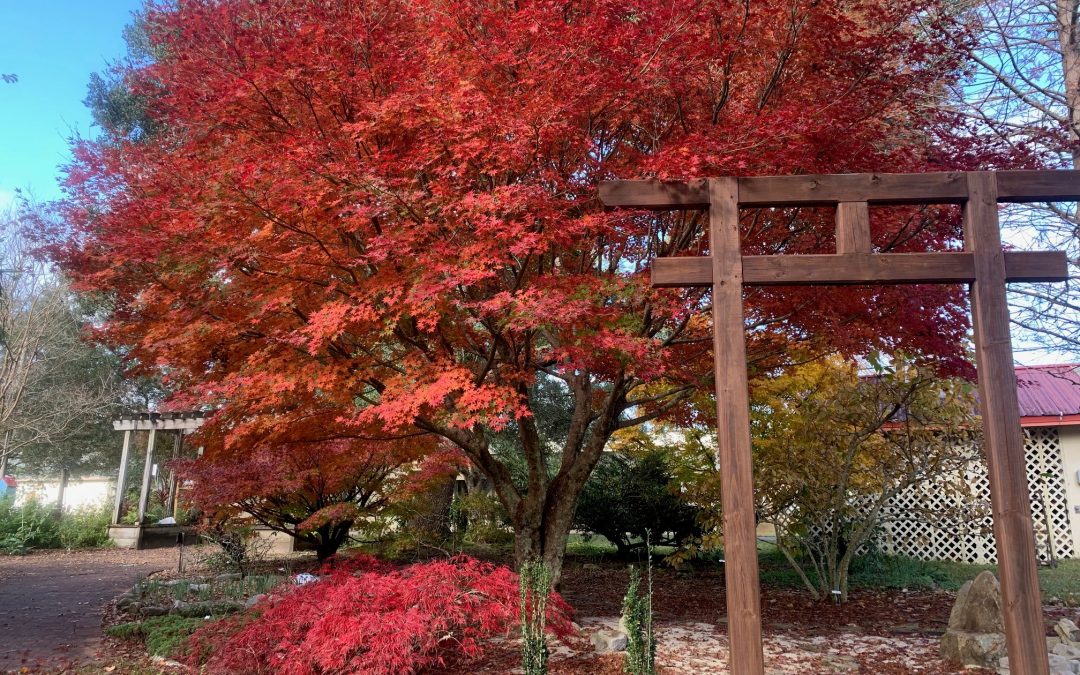
When looking for a small tree that provides a visual impact in the landscape, nothing beats a Japanese maple.
In North Florida, we have landscapes with some suitable conditions for growing a Japanese maple but these trees are not for every site. Japanese Maple plants prefer some shade, especially in the afternoon, and protection from winds. If you have a high tree canopy that allows for filtered sun throughout the day, many cultivars will grow well with this light. Soils should be moist but well drained with good organic matter. Areas with higher pH soils such as home foundations or around concrete patios usually show plants with poorer growth and nutrient issues.
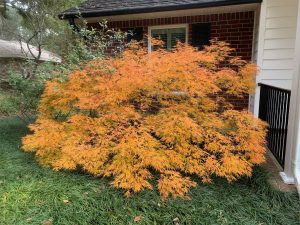
This specimen is suited to its spot with acid soil with a high Live oak tree canopy. The fall color is beautiful. Photo by Beth Bolles, UF IFAS Extension Escambia County.
Many people love the leaf color of Japanese maples, either burgundy leaf forms or selections with beautiful fall color. The palmate leaf shape also adds interest, along with varying degrees of coarse to finer textures.
My favorite characteristic of the Japanese maple is the growth form. Trees often have a layered appearance with branches extending outward, making a beautiful small canopy. Many selections have smooth bark but one cultivar, the Pine bark maple, has plated bark that looks like a pine tree.

Pine bark Japanese maple form and fall leaf color. Photo by Beth Bolles, UF IFAS Extension Escambia County.
Although the growth rate is slow to moderate, be sure to research the plant size of the cultivar you want. There are small tree forms that will reach an average of 20 feet and plants that only grow about 5 feet in twenty years. Our cool season is the best time to plant a Japanese maple if your landscape is suited for this tree.

Not all trees and woody species are welcome in the landscape. In fact, some woody species can be pesky and problematic and for lack of a better term “weeds”. Despite the fact that some of these species are native trees, bushes, and vines, many can be aggressive and problematic in the home landscape and urban settings. If you have ever cared for a flower bed or garden in the Panhandle, you are probably well acquainted with these and have pulled seedlings and small saplings out of beds, hedges, and seemingly any other nook and cranny of your landscape. If you cut them off using loppers or a saw you also know how aggressively they resprout and how extensive their root system can become. Vegetation grows quickly and often aggressively in our humid sub-tropical climates. If you leave an area of land vacant for very long here, it quickly becomes a thicket in no time. Some of our oaks, particularly water and laurel oaks, can be pesky and troublesome. It seems like I am constantly battling problem oaks in my home landscape, with varying degrees of success. I will pull out, cut out, and apply herbicide only to look up and see a substantial oak sapling rocketing up through azaleas or other hedges. Without fail this is a water or laurel oak nearly 100% of the time, with some other hardwood trees and shrub species thrown in occasionally.
What is the best way to tackle these pesky woody “weeds” when they cause persistent problems and pop up in undesirable spaces? The answer is to either mechanically removal them or employ very careful and targeted herbicide application. As a professional forester I have spent a large part of my career controlling these brush species using a host of mechanical and herbicide control methods and very well planned prescribed fires. Obviously using large heavy machinery and prescribed fire in urban and suburban settings and landscapes is not an option but using hand tools for mechanical removal and herbicides where needed and best suited is a winning combo for the home landscape.
First you want to determine what species you are dealing with and what stage of development it is in. As I mentioned, water oak and laurel oak are usually the problem oaks we encounter and can reproduce at extremely high rates and create undesirable crowded stands of stunted oak. These species are what foresters call early successional, meaning they tend to establish in forest openings and areas impacted by a disturbance such as a hurricane or windstorm. They produce large amounts of small acorns and grow very fast and they also have poor characteristics where they are susceptible to wind throw and disease. Effectively, they reproduce heavily, grow fast, and die young; that is their natural adaptation and life cycle and what causes them to be pesky and weedy in the home landscape. We don’t realize it, but our home lawns and flower beds create the perfect early successional habitat for these oaks and other brush species such as yaupon holly, titi, wax myrtle, and others. It doesn’t stop there – in heavily shaded areas, very shade tolerant oaks, brush, and vines tend to become established. Vines such as Virginia creeper, greenbriers (Smilax spp.), pepper-vine, and others are particularly annoying as these woody species also love to grow up in fences, particularly chain link, and are difficult to remove.
So what are the best methods to handle problem woody species in the home landscape? The best option is to catch them as seedlings and young plants and pull them up by the roots and all. If you can do this, you will avoid issues with resprouting. If you have larger, more well-established brush and small trees in your landscape, you can cut them back close to the ground, but you are likely to have issues with resprouting. This can be very frustrating and can result in a persistent problem. By consistently cutting these back you may be able to exhaust the plant’s reserve, but this is unlikely. Depending on the size of the root system you may be able to dig up the roots using some elbow grease and a shovel or mattock, but if significant roots are left behind, some woody species can resprout from the remaining roots. This is when simply cutting off the main stem or other mechanical methods often are not sufficient for long term control.
When dealing with well-established woody species with a significant stem size, using a properly labeled and effective herbicide can be a big time and hassle saver. You want to use a herbicide that is labeled for hack and squirt applications and/or cut stump applications. Many brush control and tough brush herbicides are labeled this way and can be applied using these methods. Herbicides with the active ingredients of triclopyr or glyphosate are the most effective for these methods and readily available for home use. Triclopyr products are usually the most effective on tough brush and woody species. Make sure the species you are targeting is listed on the label and follow the label directions exactly for the methods and concentrations to apply the herbicide correctly.
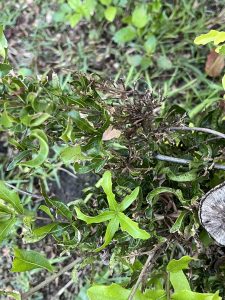
Oak resprouting from stump after herbicide treatment. Note the deformed leaves on the regrowth showing herbicide damage. Photo Credit: Ian Stone
Cut stump and hack and squirt applications require a bit of a different method of application. Instead of spraying foliage, you apply the herbicide into fresh cuts using a squirt bottle or a paint brush. You should wear proper protective equipment when working with any herbicide and this is also listed in the label. Long sleeves and pants along with chemical resistant gloves and eye protection is usually the minimum recommended. For hack and squirt, make a series of connecting cuts in a ring around the problem stem and squirt the herbicide mixture into the fresh cuts using the squirt bottle. For cut stump treatments cut the stem(s) of the problem tree or shrub off slightly above the ground and apply the mixture using a paint brush or squirt bottle, focusing on the outer portion of the stump right next to the bark. These methods work by introducing the herbicide to the cambium layer, which is the actively growing and live tissue just under the bark in woody plants. By doing this it will travel through the tissue and kill both the roots and stems. It is very important that the cuts are fresh, and the application must be made as soon as possible after the cuts are completed. Once the brush is killed back, you can wait for the stem or stump to rot or remove it once it has completely died. This method is effective at controlling resprouting but is not 100% effective on all applications. If the woody plant in question continues to resprout, you can make fresh cuts and reapply. An advantage of this method is it can be done in winter even when the plant is dormant, as it does not rely on foliage to uptake the herbicide. That means you can use it year-round, and you can take advantage of the cooler winter weather to do this labor-intensive work.
With careful work and proper technique, these methods can be beneficial to control persistent brush problems in the home landscape. When using herbicides it is very important to be aware of off target damage to desirable plants. One of the advantages of hack and squirt and cut stump applications is that they are very targeted and minimize issues with off target damage and drift. Care should be taken not to get the herbicide mixture on the stems of desirable shrubs and trees, and they can penetrate the bark and do damage, especially on thin barked species. If you have questions about how to properly use a herbicide or reading the label contact your local extension office.